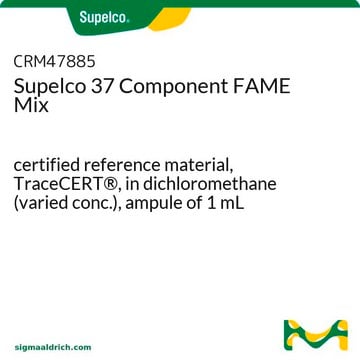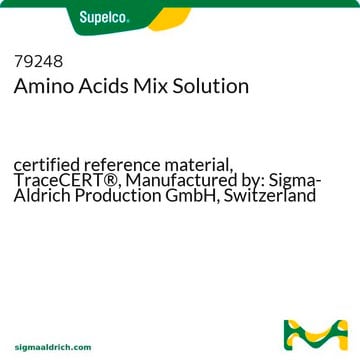Wichtige Dokumente
89683
Toluol
suitable for HPLC, ≥99.7% (GC)
About This Item
Empfohlene Produkte
Qualität
HPLC grade
Qualitätsniveau
Dampfdichte
3.2 (vs air)
Dampfdruck
22 mmHg ( 20 °C)
26 mmHg ( 25 °C)
Assay
≥99.7% (GC)
Form
liquid
Selbstzündungstemp.
997 °F
Haltbarkeit
limited shelf life, expiry date on the label
Expl.-Gr.
7 %
Methode(n)
HPLC: suitable
Verunreinigungen
≤0.05% water
Abdampfrückstand
≤0.001%
Brechungsindex
n/D 1.496 (lit.)
n20/D 1.497
bp
110-111 °C (lit.)
mp (Schmelzpunkt)
-93 °C (lit.)
Dichte
0.865 g/mL at 25 °C (lit.)
Lösungsmittelstärke ε (Al2O3)
0.29
λ
1 cm path, H2O reference
UV-Absorption
λ: 285 nm Amax: 1.0
λ: 310 nm Amax: 0.1
λ: 350 nm Amax: 0.01
SMILES String
Cc1ccccc1
InChI
1S/C7H8/c1-7-5-3-2-4-6-7/h2-6H,1H3
InChIKey
YXFVVABEGXRONW-UHFFFAOYSA-N
Suchen Sie nach ähnlichen Produkten? Aufrufen Leitfaden zum Produktvergleich
Signalwort
Danger
Gefahreneinstufungen
Aquatic Chronic 3 - Asp. Tox. 1 - Flam. Liq. 2 - Repr. 2 - Skin Irrit. 2 - STOT RE 2 Inhalation - STOT SE 3
Zielorgane
Central nervous system
Lagerklassenschlüssel
3 - Flammable liquids
WGK
WGK 3
Flammpunkt (°F)
39.9 °F - closed cup
Flammpunkt (°C)
4.4 °C - closed cup
Persönliche Schutzausrüstung
Eyeshields, Faceshields, Gloves, type ABEK (EN14387) respirator filter
Zulassungslistungen
Zulassungslistungen werden hauptsächlich für chemische Produkte erstellt. Für nicht-chemische Produkte können hier nur begrenzte Angaben gemacht werden. Kein Eintrag bedeutet, dass keine der Komponenten gelistet ist. Es liegt in der Verantwortung des Benutzers, die sichere und legale Verwendung des Produkts zu gewährleisten.
EU REACH Annex XVII (Restriction List)
Hier finden Sie alle aktuellen Versionen:
Analysenzertifikate (COA)
It looks like we've run into a problem, but you can still download Certificates of Analysis from our Dokumente section.
Wenn Sie Hilfe benötigen, wenden Sie sich bitte an Kundensupport
Besitzen Sie dieses Produkt bereits?
In der Dokumentenbibliothek finden Sie die Dokumentation zu den Produkten, die Sie kürzlich erworben haben.
Active Filters
Unser Team von Wissenschaftlern verfügt über Erfahrung in allen Forschungsbereichen einschließlich Life Science, Materialwissenschaften, chemischer Synthese, Chromatographie, Analytik und vielen mehr..
Setzen Sie sich mit dem technischen Dienst in Verbindung.








